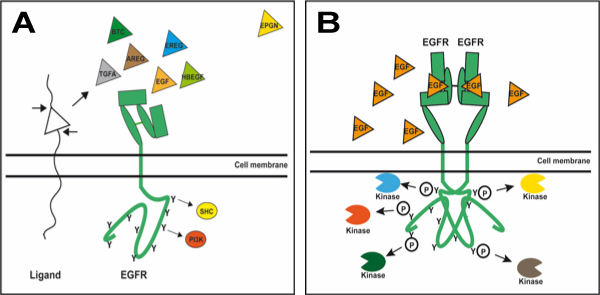- In-vivo and In-vitro-Models /
- Research /
- Division: Experimental Genetics

Division - Experimental Genetics
Group leader: Univ.-Prof. Dr. M. Dahlhoff
The research group Experimental Genetics studies the different functions and biology of the ERBB receptor system during tissue homeostasis and diseases in various organs. To analyze the ERBB receptor system we use diverse in vitro (cell culture, organoids, 3D models, and organ on a chip) and in vivo (mainly mouse models) models. A better understanding of the receptor system is crucial to improve the therapy of different diseases in which the ERBB receptors play an important role.
The ERBB receptor family belongs to the receptor tyrosine kinases (RTKs) and are expressed in a wide variety of tissues and organs. The ERBB receptor family consists of the following four members: epidermal growth factor receptor (EGFR, ERBB1, HER1), ERBB2 (neu, HER2), ERBB3 (HER3), and ERBB4 (HER4). Eleven ligands could bind the ERBB receptors, which undergo after ligand binding homo- or hetero-dimerization. After dimerization the intracellular domains of the receptors will be autophosphorylated and could activate various kinases and different signal cascades. EGFR and ERBB4 are the two autonomic receptors of the family and are able to be activated as homodimers. The two non-autonomic receptors, ERBB2 and ERBB3 form often heterodimers with each other. ERBB2 is an orphan receptor without any known ligand and ERBB3 has no intrinsic kinase activity, but heterodimers of ERBB2 and ERBB3 show the strongest mitogen activity of all ERBB receptor combinations, and their frequent presence in tumors makes them potential targets for cancer therapy.
Different environmental conditions or diseases can disturb the ERBB signaling cascade and this results in positive and negative feedback loops, which stabilize the system again. Recently, the leucine-rich repeats and immunoglobulin-like domains (LRIG) family attracted our attention because of their influence on these feedback mechanisms. Currently we are focused on LRIG1-3 proteins and their interactions with the ERBB receptors in the skin.
Currently the main research topic of the group is focused of the analysis of the ERBB receptor system in the epidermis, hair follicle and its appendixes, as well as non-melanoma skin cancer (NMSC) and psoriasis. A second research focus are gastroenterological diseases, specificly the pancreatitis and the pancreatic ductal adenocarcinoma (PDAC), as well as colo rectal cancer (CRC) and colitis.
First, we want to understand the ERBB signaling in healthy and tumorigenic tissue, and afterwards we try to use this knowledge to target the ERBB system during cancer therapy.
Publications:
1.Hedegger K, Algül H, Lesina M, Blutke A, Schmid RM, Schneider MR, Dahlhoff M. Unraveling ERBB network dynamics upon betacellulin signaling in pancreatic ductal adenocarcinoma in mice. Mol Oncol. 2020 Aug;14(8):1653-1669. doi: 10.1002/1878-0261.12699
2.Hoesl C, Hundt JE, Rose C, Wolf R, Schneider MR, Dahlhoff M. Epidermal overexpression of LRIG1 disturbs development and homeostasis in skin by disrupting the ERBB system. J Dermatol Sci. 2019 Dec;96(3):185-188. doi: 10.1016/j.jdermsci.2019.11.007
3.Hoesl C, Fröhlich T, Hundt JE, Kneitz H, Goebeler M, Wolf R, Schneider MR, Dahlhoff M. The transmembrane protein LRIG2 increases tumor progression in skin carcinogenesis. Mol Oncol. 2019 Nov;13(11):2476-2492. doi: 10.1002/1878-0261.12579
4.Hedegger K, Stumpf F, Blum H, Graf A, Schmid RM, Lesina M, Algül H, Schneider MR, Dahlhoff M. The protective effect of betacellulin against acute pancreatitis is ERBB4 dependent. J Gastroenterol. 2020 Mar;55(3):317-329. doi: 10.1007/s00535-019-01613-6
5.Dahlhoff M, Muzumdar S, Schäfer M, Schneider MR. ERBB2 is essential for the growth of chemically-induced skin tumors in mice. J Invest Dermatol. 2017 Apr;137(4):921-930. doi: 10.1016/j.jid.2016.11.023
6.Dahlhoff M, Schäfer M, Muzumdar S, Rose C, Schneider MR. ERBB3 is required for tumor promotion in a mouse model of skin carcinogenesis. Mol Oncol. 2015 Nov;9(9):1825-33. doi: 10.1016/j.molonc.2015.06.007
